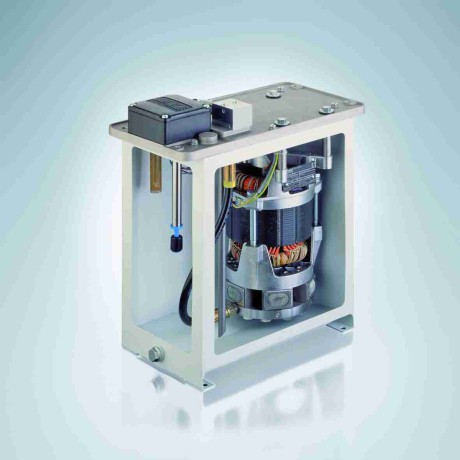With a flow rate per revolution that reaches 25 l/min and an oil volume of 100 litres, the compact motor pump group model MPN is perfectly suitable for the balancing control. In big machining centres, it is worth making use of the hydraulic control both in the spindle head balancing and in the worktable balancing.
 Actually, the systems by Hawe Hydraulik SE in Munich allow decreasing the consumption of electrical energy and of resources of the machining centre. In that way, they not only share in the energy efficiency but, during the production, they also decrease the TCO – Total Cost of Ownership of the machine. Adopting a hydraulic balancing control, you can also notably reduce the sizes of the motors for the vertical axes of the spindle head and of the worktable. This permits more dynamic axis motions and a further current saving. A system of hydraulic balancing control is an autarkic system: once powered by pressure, it is not necessary to supply it with further energy. A hydraulic cylinder, connected with a pressure accumulator bears the weight of the spindle head and of the worktable. The pressure inside the system is set in such a way that the cylinder force compensates the weight. For the vertical movement of the spindle head, it is only necessary to surpass the friction force and the mass inertia, for which a much lower engine power is necessary. The motor pump group is necessary only for the system filling in the commissioning phase and in case of after-sale-service activities. In both cases, the time is not relevant and therefore the group power must not be big. For such cases it is for instance suitable the compact motor pump group model MPN because it satisfies the criteria of high operating pressure, low power, small sizes and of the big tank volume to fill or to empty the system. To set the desired operating pressure, too, when the system is filled, you need a pressure regulating valve for the pressure supply. While operating, a pressure switch monitors the pressure of the system that signals the non-conformity, by excess or by defect, of the established pressure range. The operator can then adopt the opportune, measures, for instance assessing whether in the system there are some leakages or controlling the preload of the pressure accumulator. A pressure relief valve makes the pressure accumulator safe while in case of service interventions the accumulator is emptied through a drain cock. The compact BA-type valve block includes these standard components. No pipes and related assembly works are needed, nor a block apart.
Actually, the systems by Hawe Hydraulik SE in Munich allow decreasing the consumption of electrical energy and of resources of the machining centre. In that way, they not only share in the energy efficiency but, during the production, they also decrease the TCO – Total Cost of Ownership of the machine. Adopting a hydraulic balancing control, you can also notably reduce the sizes of the motors for the vertical axes of the spindle head and of the worktable. This permits more dynamic axis motions and a further current saving. A system of hydraulic balancing control is an autarkic system: once powered by pressure, it is not necessary to supply it with further energy. A hydraulic cylinder, connected with a pressure accumulator bears the weight of the spindle head and of the worktable. The pressure inside the system is set in such a way that the cylinder force compensates the weight. For the vertical movement of the spindle head, it is only necessary to surpass the friction force and the mass inertia, for which a much lower engine power is necessary. The motor pump group is necessary only for the system filling in the commissioning phase and in case of after-sale-service activities. In both cases, the time is not relevant and therefore the group power must not be big. For such cases it is for instance suitable the compact motor pump group model MPN because it satisfies the criteria of high operating pressure, low power, small sizes and of the big tank volume to fill or to empty the system. To set the desired operating pressure, too, when the system is filled, you need a pressure regulating valve for the pressure supply. While operating, a pressure switch monitors the pressure of the system that signals the non-conformity, by excess or by defect, of the established pressure range. The operator can then adopt the opportune, measures, for instance assessing whether in the system there are some leakages or controlling the preload of the pressure accumulator. A pressure relief valve makes the pressure accumulator safe while in case of service interventions the accumulator is emptied through a drain cock. The compact BA-type valve block includes these standard components. No pipes and related assembly works are needed, nor a block apart.



